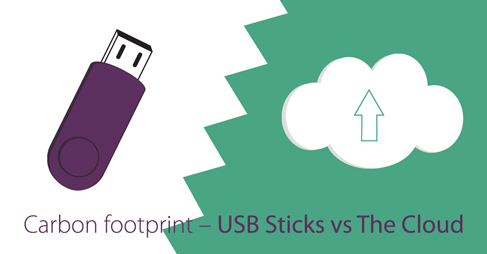USB Sticks vs The Cloud - Carbon Footprint Wars!

When buying USB sticks to share high resolution images and videos with clients, you might be wondering if uploading them to the cloud might be a cheaper and more environmentally friendly option.
With the rise of file sharing websites such as Dropbox and WeTransfer, cloud storage is fast becoming one of the most convenient ways to share and access digital images. This is especially true for professional photographers, who work with a lot of high resolution files on a daily basis. But when choosing how to share those images, it's important to assess the carbon footprint of each option.
A recent Panorama report on BBC One highlighted the drastic impact cloud storage is having on the environment. When thinking about the cloud storage industry, you would be forgiven for not realising the impact it was having - it is invisible after all!
Is the cloud eco friendly?
While uploading images to the cloud is often marketed as a convenient and secure option to share images and files, it's worth considering it's huge carbon footprint. According to Greenpeace, the carbon footprint of cloud storage is now greater than the aviation industry!
Cloud storage relies on large facilities, known as data centers, to store data. Data centres consume enormous amounts of energy to power and cool the servers. Often, the electricity used to power them also comes from fossil fuels, which contributes further to climate change. The industry is under extreme pressure from environmental organisations to switch to renewable energy sources wherever possible.
Are USB sticks eco friendly?
USB sticks are significantly more environmentally friendly when compared to cloud storage. Whilst USB sticks are not without their own environmental impact (through the use of resources such as plastic and metal), they use less energy and produce less waste overall. What's more, there are many USBs made of eco-friendly materials these days, and responsible suppliers do everything in their power to reduce their carbon footprint at every touchpoint.
USB sticks are also more portable, so you can access your files wherever you go, without having to re-download from the cloud. USB-C memory sticks are particularly useful for accessing images on the go, thanks to their compatibility with many smartphones and tablets.
As with all technology products, we recommend that USB sticks are disposed of correctly once you have finished them, so that they don't end up in landfill.
Other advantages of USB sticks over the cloud.
USB sticks only have one-off, upfront cost, whereas file sharing and cloud storage websites often have ongoing costs. By offering a tangible and personalised product that clients can touch and feel, USB sticks also enhance the perceived value of your work. We know that professional photographers invest a considerable amount of time and money into their craft. Customers pay appropriate fees for high-quality photos that they simply cannot get anywhere else. By investing in a USB stick and even a presentation box with prints, you can add perceived value to your work when compared to a simple download link on an email.
Memory sticks also give your clients complete control over their images' security and privacy. Cloud storage has come under scrutiny in recent years for data breaches and security vulnerabilities, and it is well known that cloud based data is vulnerable to hackers.
A bonus of a physical storage device is that you don't need an internet connection to download images - and you can do it faster. USB3.0 memory sticks in particular offer faster data transfer speeds when compared to cloud storage. Time is money in this business and when you're handling numerous, large file size images, every minute counts!
Our conclusion on USB sticks vs The Cloud
However you choose to share your work, we always recommend backing up files locally. This is good practice to share with clients too, as neither cloud based or physical file storage solutions are entirely fool proof.
Ultimately, while cloud storage may seem like a convenient option for sharing imagery, the environmental impact it has alone is enough to convince us that there must be a better solution. With the ongoing monthly costs, security vulnerabilities, and limited accessibility of cloud storage solutions, USB sticks become a much more desirable option.
If you want to learn more about the actions we are taking to reduce the carbon footprint of our USB products, then get in touch with our friendly team today who will be happy to share more information with you.
